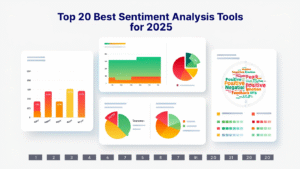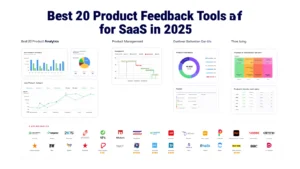In today’s fast-paced business environment, making informed decisions is crucial. Market research provides the necessary insights to understand market conditions, customer preferences, and competitive dynamics. This blog explores what market research is, how it works, its importance, and how you can effectively conduct it to drive your business forward.
What Is Market Research?
Market research involves gathering and analyzing market information, including understanding consumers’ needs and preferences, the competitive landscape, and industry trends. It helps businesses make data-driven decisions by providing insights into various market aspects.
How Market Research Works?
Market research works by systematically collecting and analyzing data to answer specific business questions. The process typically involves:
- Defining the Problem: Identifying what information is needed and why.
- Designing the Research: Choosing the methods and tools to gather data.
- Collecting Data: Using surveys, interviews, or other methods to gather information.
- Analyzing Data: Reviewing and interpreting the data to draw conclusions.
- Reporting Findings: Presenting the results and recommendations to inform decisions.
Why Market Research Is Important?
Market research is essential for businesses seeking to thrive in a competitive landscape. Here’s a deeper look into why it’s so crucial.
Informed Decision-Making
Market research provides factual data that supports decision-making. Instead of relying on gut feelings or assumptions, businesses can use market research to make decisions based on real data. This reduces uncertainty and increases the likelihood of success by aligning strategies with market realities.
Understanding Consumer Needs and Preferences
Consumer preferences can shift rapidly, and market research helps businesses stay in tune with these changes. By understanding what customers want and need, businesses can tailor their products, services, and marketing efforts to better meet those needs, enhancing customer satisfaction and loyalty.
Identifying Market Opportunities
Market research helps identify gaps in the market where demand is unmet. This can reveal new business opportunities, such as potential new products or services, or underserved market segments. By exploring these opportunities, businesses can innovate and expand their offerings to capture new revenue streams.
Assessing Market Potential
Before launching a new product or entering a new market, it’s crucial to assess its potential. Market research provides insights into the size of the market, growth potential, and customer segments. This information helps businesses gauge whether the market is worth entering and how best to position their products.
Minimizing Risks
Every business decision carries some level of risk. Market research helps mitigate these risks by providing a clearer picture of market conditions, consumer behavior, and competitive dynamics. By understanding potential risks and challenges, businesses can develop strategies to address them and avoid costly mistakes.
Gaining a Competitive Edge
Understanding your competitors is essential for staying ahead. Market research allows businesses to analyze competitors’ strengths, weaknesses, strategies, and market positioning. This competitive intelligence helps businesses differentiate themselves and develop strategies that leverage their unique strengths.
Improving Marketing Effectiveness
Effective marketing relies on a deep understanding of the target audience. Market research provides insights into consumer behavior, preferences, and attitudes, which can inform the development of targeted marketing campaigns. This ensures that marketing efforts are relevant and resonate with the intended audience, leading to higher engagement and conversion rates.
Enhancing Customer Experience
Customer satisfaction is a key driver of business success. Market research helps businesses understand what drives customer satisfaction and loyalty. By identifying areas for improvement and addressing customer pain points, businesses can enhance the overall customer experience and build stronger relationships with their audience.
Supporting Strategic Planning
Strategic planning involves setting long-term goals and determining the best path to achieve them. Market research provides the necessary data to inform strategic planning, helping businesses set realistic objectives, allocate resources effectively, and plan for future growth.
Tracking Market Trends
Markets are dynamic, and trends can evolve quickly. Regular market research helps businesses stay updated with current trends, consumer preferences, and emerging opportunities. This ongoing awareness allows businesses to adapt their strategies and stay relevant in a changing market landscape.
Objectives of Market Research
The main objectives of market research are:
- Understanding Market Dynamics: Gain insights into market size, growth potential, and trends.
- Customer Insights: Identify customer preferences, behaviors, and buying patterns.
- Product Development: Gather feedback on product concepts and features.
- Marketing Strategies: Develop effective marketing strategies based on consumer needs and competitive analysis.
- Sales Forecasting: Predict future sales and market demand.
Types of Market Research
Market research can be categorized into two main types: primary research and secondary research. Each type serves different purposes and provides unique insights. Here’s a brief overview of each:
Primary Research
Primary research involves collecting new, original data directly from sources. It is tailored to specific research questions and provides firsthand insights. There are several methods for conducting primary research:
- Surveys: Questionnaires distributed to a target audience to gather quantitative data on their preferences, behaviors, and opinions.
- Interviews: One-on-one discussions with individuals to gain in-depth qualitative insights into their experiences and attitudes.
- Focus Groups: Group discussions led by a moderator to explore perceptions and opinions on a specific topic.
- Observations: Watching and recording behavior in natural settings to understand how people interact with products or services.
- Experiments: Testing hypotheses by manipulating variables and observing outcomes in controlled environments.
Secondary Research
Secondary research involves analyzing existing data that has already been collected by other sources. It uses data from previous studies, reports, and publications. Secondary research methods include:
- Industry Reports: Detailed analyses published by industry experts or market research firms, providing insights into market trends and forecasts.
- Market Studies: Research reports that cover specific aspects of a market, such as size, growth, and segmentation.
- Academic Papers: Research articles published in academic journals, offering theoretical and empirical insights on various topics.
- Government Data: Statistics and reports from government agencies that provide information on demographics, economic indicators, and industry performance.
- Competitor Analysis: Reviewing public information about competitors, such as financial reports, marketing strategies, and product offerings.
Both primary and secondary research are valuable for understanding different aspects of the market. Primary research provides specific, tailored insights directly from the source, while secondary research offers a broader context and background information. Combining both types can provide a comprehensive view of the market and support more informed decision-making. You can hire market research agency to conduct the research.
How to Conduct Market Research?
Conducting market research involves a systematic approach to gather and analyze data about your market, customers, and competitors. Here’s a simplified guide on how to conduct effective market research:
Define Your Objectives
Start by clearly defining what you want to achieve with your market research. Identify the specific questions you need answered or the problems you need to solve. This helps focus your research efforts and ensures you gather relevant information.
Choose Your Research Methods
Select the research methods that best suit your objectives. There are two primary types:
- Primary Research: Involves collecting new, original data directly from sources. Methods include surveys, interviews, and focus groups.
- Secondary Research: Involves analyzing existing data from sources like market reports, industry studies, and online databases.
Design Your Research Tools
Create the tools you’ll use to collect data. This might include:
- Surveys and Questionnaires: Design questions that are clear, concise, and relevant to your objectives.
- Interview Guides: Prepare a list of questions or topics for in-depth interviews.
- Focus Group Scripts: Develop a structured outline for facilitating focus group discussions.
Collect Data
Implement your research methods to gather data:
- Conduct Surveys: Distribute surveys to your target audience via email, online platforms, or in person.
- Conduct Interviews: Arrange and conduct interviews with key stakeholders or target customers.
- Run Focus Groups: Facilitate group discussions with a diverse set of participants to gain multiple perspectives.
Analyze the Data
Once data is collected, analyze it to extract meaningful insights:
- Quantitative Analysis: Use statistical methods to analyze numerical data from surveys and questionnaires.
- Qualitative Analysis: Identify themes and patterns from interviews and focus groups.
Interpret the Findings
Review the analyzed data to draw conclusions about your research objectives. Look for trends, patterns, and key takeaways that address your initial questions. This step involves translating data into actionable insights.
Report Your Findings
Prepare a report to present your findings and recommendations:
- Summarize Key Insights: Highlight the most important findings and how they address your research objectives.
- Include Visuals: Use charts, graphs, and tables to make data more understandable.
- Provide Recommendations: Offer actionable suggestions based on your findings.
Implement Insights
Apply the insights gained from your research to make informed decisions. This might involve adjusting your marketing strategies, developing new products, or entering new markets based on the data collected.
Monitor and Adjust
Market research is an ongoing process. Continuously monitor market trends and customer feedback to refine your strategies and stay responsive to changes. Regularly updating your research helps ensure that your decisions remain relevant and effective.
Benefits of Market Research
The benefits of market research include:
- Better Decision-Making: Access to accurate data helps in making informed decisions.
- Understanding Market Needs: Helps in tailoring products and services to meet market demands.
- Improved Marketing Strategies: Provides insights to create targeted and effective marketing campaigns.
- Competitive Intelligence: Offers information on competitors, aiding in strategic planning.
- Risk Mitigation: Identifies potential risks and challenges, allowing businesses to address them proactively.
Examples of Market Research
Here are some examples of market research:
- Customer Surveys: Collecting feedback from customers about their satisfaction with a product or service.
- Focus Groups: Gathering a group of people to discuss their opinions on a new product concept.
- Competitive Analysis: Reviewing competitors’ strengths, weaknesses, and market positioning.
- Industry Reports: Analyzing reports that provide insights into market trends and forecasts.
Conclusion
Market research is a valuable tool for understanding your market, making informed decisions, and gaining a competitive edge. By following the steps outlined and leveraging the benefits of market research, you can better meet customer needs, identify opportunities, and reduce risks. At Pearl Lemon Experiences, our team is here to assist you with comprehensive market research and insights, helping you drive your business to success.
FAQs
Common mistakes include not defining clear objectives, using biased or leading questions, neglecting secondary research, failing to analyze data comprehensively, and not validating research findings with additional data.
The frequency of market research depends on the industry and business needs. However, it is generally advisable to conduct market research annually or biannually, or more frequently if there are significant market changes or major business decisions.
Qualitative research focuses on understanding opinions, behaviors, and motivations through methods like interviews and focus groups. Quantitative research involves collecting numerical data that can be statistically analyzed, such as through surveys and experiments.
Small businesses can use cost-effective methods such as online surveys, social media polls, and secondary research. They can also consider partnering with market research firms that offer affordable packages or using free or low-cost research tools.
Effective tools include survey platforms like SurveyMonkey or Google Forms, analytics tools like Google Analytics, social media listening tools like Hootsuite or Brandwatch, and industry reports from sources like Statista or Nielsen.
Market research can be done in-house if you have the expertise and resources. However, outsourcing to a professional market research firm can provide access to specialized skills, tools, and unbiased perspectives, which can be beneficial for complex or large-scale research projects.





